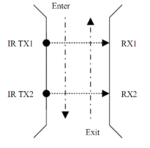nithin kamath
Junior Member level 1
Hi... I need a help from u all... I am doing "A bidirectional Visitor Counter" using a pair of Infrared LEDs and Photo Diodes..... I googled about this, but each and every result uses a microcontroller in it....
I am a Computer Science Student and dont have much Idea about Microcontrollers....
So can i Make a Visitor Counter Without using any Microcontroller...???
I have an Idea,, But before trying that, I thought i can get Much more Ideas from u people who are very much concerned about Electronics.....
Please Help me .... Make it as simpler as possible..... Hope u all can help me...
Thanks in advance
I am a Computer Science Student and dont have much Idea about Microcontrollers....
So can i Make a Visitor Counter Without using any Microcontroller...???
I have an Idea,, But before trying that, I thought i can get Much more Ideas from u people who are very much concerned about Electronics.....
Please Help me .... Make it as simpler as possible..... Hope u all can help me...
Thanks in advance


